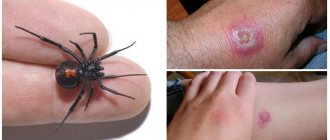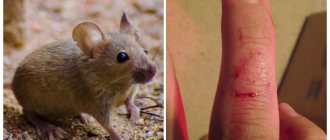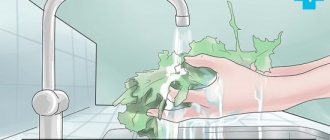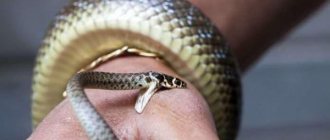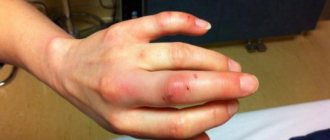What kind of insect is a horsefly?
The horsefly is a large blood-sucking insect from the order Diptera. More than 4,000 species are known; about 190 species live in the countries of the former USSR. Horseflies are most numerous in the taiga zone, forest-steppes and forests. In arid areas they live along the banks of rivers and lakes, in mountainous areas - right up to the zone of eternal snow.
Only females drink the blood of animals and humans, while males feed on plant nectar. In appearance, they are smaller than females and have contiguous compound eyes, while in females the eyes are separated by a chitinous stripe. Females have a proboscis, which is equipped with a cutting apparatus. When a horsefly bites, a person feels severe pain. The insect injects saliva into the wound, which contains substances that prevent blood clotting, so the wound bleeds for a long time.
Horseflies of three genera are most widespread in Russia; in everyday life they are called rainflies, lacewings, or horseflies themselves. The size of the insect can be from 6 to 30 mm; in appearance, the horsefly looks like a large gray fly with large eyes. The wings can have a gray or marbled mesh pattern and be variegated.
The flight of horseflies begins at an air temperature not lower than +15 °C; in hot weather - above +32 °C - horseflies are inactive. Insects come to life before rain, but do not fly during wind and bad weather. The exception is rainflies, which can attack even in light rain.
The reproduction of horseflies is closely related to water. Females lay eggs on plant stems near bodies of water. The eggs hatch into larvae that continue to exist in water or moist soil. Blind fly larvae are an important component of the biocenosis of soil restoration.
Sometimes horseflies are called gadflies. This is incorrect because botflies are a different insect and do not drink blood. Adult gadflies are born with a supply of all necessary substances and do not feed during life. They do not bite animals or humans, but females lay eggs on the hair or inject larvae into the animal’s nostrils. Further, the larvae lead a parasitic lifestyle until they become adults. The most significant in terms of harm caused are subcutaneous, nasopharyngeal and gastric gadflies, which parasitize horses, deer, cattle and camels. Cases have been described in which subcutaneous botfly larvae developed in humans, but this is rather an exception to the rule.
Unlike gadflies that are yellow-gray or yellow-brown in color, their proboscis and other mouthparts are underdeveloped. Some of them are similar in appearance to bumblebees.
Gadfly or horsefly: who can bite us
Gadfly is a collective concept.
We often call all blood-sucking large and medium-sized flies this way. However, there is a significant difference between horseflies and gadflies. This is what a gadfly looks like
Gadflies are not bloodsuckers. Their mouth is reduced, that is, these flies do not feed on blood. They live off what they have accumulated in the larval phase while in the body of a mammal or bird. When biting a living creature, the goal of the gadfly is to lay eggs under the skin of the victim.
Among the 150 species of these parasites, only one attacks humans - the human skin botfly, but its habitat is Central America. Therefore, at the moment it does not pose a danger to the residents of Russia.
A little about gray flies
Considering the above, it is worth talking about other flies called horseflies, which many people often mistakenly call gadflies or waterflies. It is these insects that often bother us. Horseflies are large dipterans with sharp and hard stylets, jaws and a dense fleshy proboscis.
Horseflies live near bodies of water and where there are grass and forest areas everywhere from the Arctic to the Antarctic
Unlike true gadflies, horseflies do not hide eggs in the bodies of animals, birds and people. Parasites lay their offspring near bodies of water on plants and soil. But before doing this, the females must drink blood.
Alas, each of us often encounters this blood-sucking dipteran insect when going to the forest, park, or on vacation in the countryside. These large flies always live where there is a green area or body of water nearby. Horseflies practically do not live in urban conditions. Farms where livestock are raised are considered a paradise for their life. After all, it is on the body of large mammals that the females of these insects parasitize. At the same time, they do not hesitate to attack people, which usually ends disastrously for both horseflies and humans. As a rule, when bitten, the insect dies (usually the victim manages to slam the horsefly), and the victim receives a painful lesion.
Males are absolutely safe for people and animals, as they feed on nectar
Don't think that horseflies have poor eyesight. Their eyes see everything in detail. And the smell of fresh blood, sweat, perfume aromas and excrement attracts these bloodsuckers from afar.
Why is a horsefly bite dangerous?
Horsefly vinegar is accompanied by severe pain. Insects are very intrusive and difficult to drive away from an animal or person. Horseflies navigate mainly by sight, so you can run away from them.
After a horsefly bite, a lump forms and the surrounding skin turns red. Blood can ooze from the wound for a long time without clotting. The person feels itching and burning. In normal cases, symptoms disappear after a few days.
Allergy to a horsefly bite is a fairly rare occurrence. Sensitive people may develop local swelling, severe redness and itching, rash, deterioration in health, and increased body temperature. Possibly enlarged regional lymph nodes. Subsequently, a hard, painful nodule sometimes forms at the site of the bite, which is typical of an infected wound.
Any poisoning of the body after a horsefly bite or the development of severe allergic reactions (systemic edema, anaphylactic shock) have not been observed in practice.
However, you should know that when bitten, a horsefly can serve as a mechanical carrier of blood-borne diseases:
- anthrax,
- tularemia,
- filariasis.
Preventive measures
There are a number of precautions you can take to avoid insect bites. It is especially important to follow these tips if you are allergic to stings:
- Move slowly and don't panic if you encounter wasps, hornets or bees. Don't wave your arms.
- If you are going outside when insects are most active, such as sunrise or sunset, wear long sleeves and pants.
- Avoid walking without shoes outdoors.
- Apply insect repellent to exposed skin.
- Avoid using items with strong odors such as soaps, shampoos and deodorants as they may attract insects.
- Avoid flowering plants, places where food is served or where garbage is stored.
- Avoid resting near ponds and swamps. Dangerous insects are most often found near water.
- Keep doors and windows closed or install fine mesh to prevent insects from entering your home. Also keep your car windows closed.
- Don't break bee evidence. Find a professional to get rid of them.
Symptoms
When bitten by a horsefly, the symptoms are:
- pain,
- burning,
- itching,
- edema,
- redness,
- blood oozes from the wound.
The most serious consequence of a horsefly bite can be infection of the injury site and the development of purulent inflammation. To prevent this from happening, it is necessary to use insect repellents and treat damaged areas with antiseptics. With proper treatment, swelling from a horsefly bite goes away in 1–2 days.
Treatment of a horsefly bite
How to treat a horsefly bite? To do this, it is necessary to disinfect the wound, relieve swelling, and reduce pain. They use both pharmacy and folk remedies.
The steps to treat horsefly bites are approximately as follows.
- Apply pressure to the bite site to reduce the spread of horsefly saliva into the skin.
- A simple trick to relieve itching from a horsefly bite is to cool the swelling with a piece of ice or other cold object.
- Wash the wound with cool water and regular soap, or laundry soap.
- Cauterize the bite site with alcohol, brilliant green, iodine, treat with hydrogen peroxide - any antiseptic will do.
You should consult a doctor if a person has suffered from a large number of insect bites, or if a severe allergic reaction develops. In other cases, you can manage with self-treatment.
The pharmacy sells special ointments for insect bites - you can also use them.
If the pharmacy is out of reach, then treatment with folk remedies is used.
The juice of many plants has an astringent and anti-inflammatory effect. It will stop the bleeding and reduce the inflammatory reaction: swelling, redness. You can use any of the following herbal remedies:
- plantain,
- dandelion leaf and stem,
- parsley,
- yarrow,
- mint,
- black nightshade,
- aloe juice
Another way to treat swelling from a horsefly bite: wipe the affected area with a slice of lemon, an onion or a clove of garlic.
In places where there are a lot of horseflies, it is necessary to use insect repellents. Let's talk about how to protect yourself from horsefly attacks.
Specifics of inflammation in different parts of the body
According to statistics, most often stinging insect bites occur on human limbs. If a leg or arm is swollen from such a bite, the situation is, of course, unpleasant, but quite tolerable, although the injured limb may even take on a frightening appearance.
“Last summer I was bitten by some insect, my hand became terribly swollen, so much so that I could not move my fingers. It seems like nothing unusual, but it’s really scary that it won’t stay like this forever. I walked around with this pillow for about a week, and then it gradually went away. Although after the bite there was a lump on the back of the hand that remained for a couple of weeks.”
Yaroslav, Ramenskoye
A much more serious situation is when, for example, a hornet or wasp stings the eye, eyelid, lip or tongue. A tumor after such a bite prevents a person from living fully, receiving information from the outside world, and speaking. In addition, some symptoms that appear after such an attack can seriously threaten the health, and sometimes the life of the victim.
“It was scary when a bee bit me in the eye. This guy walks around the garden, and half of his face is swollen like a ball, and even turned a little blue. We showed it to the doctor, he said that we were lucky and it’s okay, it will go away on its own. Now the eyelid seems to be opening a little, but yesterday I couldn’t even move it.”
Alexander, Vladimir
In conclusion, I would like to once again draw attention to the fact that if, as a result of an insect bite, symptoms of general poisoning appear, a rash all over the body, shortness of breath, nausea or extensive swelling, the victim should be taken to the hospital. Even a single bee sting can in some cases cause severe allergic reactions and lead to anaphylactic shock.
You can never know for sure exactly how the body will react to the poison that has entered it, and if you are too careless, you may not even have time to call an ambulance. Therefore, after a bite, carefully monitor your condition or the condition of a loved one, and if the first alarming symptoms appear, call the hospital.
Useful video about different reactions to insect bites: from swelling to anaphylactic shock
What can be done to protect against insect bites and what products to use in case of an allergic reaction
Warmer weather increases the number of insects that can bite or sting. Most often, people do not know what kind of insect bit them and how dangerous it is. The consequences of such bites can be different - from ordinary redness to a threat to life.
We have compiled for you a selection of the top 8 most common bites that you can feel while walking in the city or abroad on an exotic vacation.
How to protect yourself from horsefly bites
Means of protection against blood-sucking insects include measures to prevent them from entering the home and repelling them in nature.
Consider the daily activity of horse flies. They attack only during daylight hours in good weather.
Let's summarize briefly. Of course, it is better to prevent attacks by blood-sucking insects by using protective equipment. If you are nevertheless bitten by a horsefly, there is no particular reason to worry. Apply ice to the wound, wash with cold water and soap and lubricate with any disinfectant solution. To relieve swelling from a horsefly bite, there are several remedies: anti-inflammatory ointments, plant-based insect balms, lotions made from soda or ammonia. If you don’t have any of the above on hand, use a green pharmacy: a leaf of plantain or wormwood, dandelion juice or a piece of onion will help relieve pain and swelling.
Summer time is picnic season. Outdoor recreation is always associated with inconvenience in the form of annoying insects. If repellent doesn't work and you get bitten by a horsefly, learn the symptoms so you can begin treatment and remedy the consequences. Doctors tell you why it is dangerous and how to relieve swelling using various means.
What is the danger?
What we used to call a wasp “bite” is actually an injection from a sharp sting. Moreover, as soon as this small spear penetrates the skin, a specific poison is sprayed out of it, to which more than 2% of the population of our planet are hypersensitive. And if for many a wasp sting is only a painful lesion of the skin, then for this category of people it is a dangerous lesion of the body that can even provoke anaphylactic shock. Indeed, to a dose of a cocktail of biologically active substances, such as acetylcholine, neurotoxin, histamine, etc., the reaction can be the most unpredictable. And if you don’t know what to do after receiving a wasp sting, swelling and itching will add to the rash, as well as other symptoms.
If there is no hypersensitivity to wasp venom, a single bite will not cause much harm to health. But the difficulty is that this striped insect has a very large supply of poison, which is enough for several attacks. It is also worth noting that wasps are predators that live in entire colonies. By disturbing their nest, a person can cause himself to be attacked by many individuals. A large number of bites can cause general intoxication.
This poses the greatest danger to people who suffer from diabetes, allergies and asthma, as well as to children, the elderly and pregnant women, whose bodies cannot cope with toxins on their own. Therefore, knowing if you have received a wasp sting, how to remove the swelling and overcome intoxication is simply your responsibility. Sometimes having such information can help save a person’s life no less.
There are many bacteria on the legs and body of wasps (in fact, like all insects), which can enter the human body during a bite. After such migration, microorganisms become accustomed to the new environment and begin to multiply, resulting in infectious purulent abscesses, and sometimes even various intestinal diseases. At the first signs of infection, you should not use ointment for a wasp sting; it is advisable to immediately seek medical help. Otherwise, the inflammatory process can spread and cause significant harm to health.
Causes of bites
Horseflies are insects from a species of midges, or blood-sucking dipterans. They mainly live in pastures where cows, horses and other animals graze. Their activity begins in early summer, during the breeding season. To lay eggs, the female needs animal blood, so horseflies flock to the field in search of victims to obtain it.
If there is no pasture nearby, insects look for other warm-blooded objects. They are attracted by the smell of sweat; they are able to recognize it from several tens of meters away. If you are on a picnic, you can easily become the target of a horsefly bite.
In Russia, three types of horseflies are most often found:
- bovine - live on the edges of forests and fields, near bodies of water;
- lacewings - prefer rivers and lakes, found in the sand on the beach;
- raincoats - activated before a thunderstorm.
Why is a horsefly bite dangerous?
About 150 species of horseflies live in nature, but only the three listed above are dangerous to humans. During the period of active reproduction, the female lays up to 500 eggs and looks for warm-blooded prey. She makes a puncture in the skin with a sharp proboscis, injecting a special poison into the blood, which liquefies it and prevents the wound from healing. This substance attracts other insects - flies and mosquitoes, which continue to bite.
A horsefly bite is dangerous for humans due to the occurrence of an allergic reaction to the insect substance. Redness instantly forms on the spot with a thickening underneath, which itches and itches. Swelling and itching are signs of poisoning of the body. In some cases, deaths are possible if a person is allergic and there are no antihistamines on hand.
Another danger is the possibility of infectious infection. Horseflies bite pigs, cows and other animals, carrying particles of blood on their proboscis and leaving them in a wound on human skin. There are known cases of infection with the following diseases:
- anthrax;
- filariasis;
- tularemia and others.
At first, the infected person does not consult a doctor, believing that if the bite itches, suppuration, swelling and itching appear, this is a temporary phenomenon and can be relieved at home. Time is wasted; it is much more difficult to treat a horsefly bite and its consequences a few days later, including cleaning the blood from infections.
Why do midges bite your legs?
Often insects bite your legs. This is due to the fact that this part of the body is almost always open. In addition, in the summer they are the least sensitive to external influences.
Another reason for the increased attention of insects to the lower extremities is the high content of capillaries in the legs, that is, this part of the body contains a lot of blood. Therefore, in the summer, your feet will always be attacked by live midges.
Symptoms
It is easy to distinguish a horsefly bite: the female can not only bite, her proboscis has a razor-sharp tip that literally cuts the skin, unlike mosquitoes and other insects. The wound site may immediately swell and form a bruise that does not go away for a long time. The first symptoms include painful itching, which is not relieved by either water or cold.
The venom that horseflies inject into the skin triggers an immune response. Children and allergy sufferers are especially sensitive. Often the reaction to a bite is manifested by the following symptoms:
- chills;
- temperature increase;
- vomit;
- nausea;
- headache;
- dizziness;
- loss of consciousness.
If these signs appear, you should immediately call an ambulance or go to a first aid station as soon as possible. An allergic reaction to a bite manifests itself in different ways. If the immune system is weak, which often happens in children or pregnancy, the entire leg or arm may swell.
The horsefly bite in the photo looks different for everyone. Most people who do not have problems with the immune system see only a small red spot on the body after 5-6 hours. But in children, as well as during pregnancy, an allergy to the bite of a horsefly begins to occur when an anticoagulant is secreted by the insect and injected into the skin.
Often the consequences appear within 5-7 days and look like this:
- enlargement of the lymph nodes closest to the site of the bite;
- a swollen, dense lump forms on the skin, which takes a long time to resolve;
- after scratching the wound, suppuration begins.
In people with poor blood clotting, it is difficult to remove swelling from a horsefly bite, since the wound constantly bleeds.
In the first 2-3 hours, an allergy to a horsefly bite is observed. It usually goes away after taking an antihistamine, but in some cases these symptoms in humans require medication. Those most susceptible to it are those who have a history of a tendency to autoimmune processes.
- rash like urticaria;
- low blood pressure;
- runny nose;
- sweating;
- vomit;
- dyspnea.
If first aid is not provided, anaphylactic shock is possible due to the entry of horsefly saliva antigens into the general bloodstream and the development of autoimmune reactions.
Signs of parasitism on the skin
You can see what a horsefly bite looks like in the photo. Symptoms in humans are unpleasant, painful, and can occur with varying degrees of intensity. Main symptoms:
- instant redness of the skin;
- burning, severe itching;
- pain at the site of the bite;
- prolonged bleeding;
- puffiness, swelling;
- When pathogenic microorganisms enter the wound, suppuration develops.
The reaction to a bite in children is much stronger; red spots are clearly visible on sensitive skin. An allergy to a bite in sensitive people is manifested by large-scale redness of the skin, an additional rash, severe swelling, and unbearable itching.
After a horsefly bite, it is recommended to wash the wound and disinfect it, but in the field this can rarely be done. For people with strong immunity, the consequences of a horsefly bite are not so terrible, while people with a tendency to allergies have to undergo special treatment. The horsefly bite in the photo is shown below; you can assess the scale of the problem.
Emergency care for a bite An infection gets into the open wound, which complicates the situation even more. Constant scratching is dangerous due to the addition of a secondary infection. In serious situations, local antibiotics must be used. But if everything is done correctly, you can avoid terrible complications.
- If you are bitten by a horsefly, you need to disinfect the wound as quickly as possible and stop the bleeding.
- In the field, the affected area is lubricated with saliva. But it is better to wipe the bite with any product containing alcohol.
- Another way to treat horsefly bites is to rinse the wound with clean running water. And even better with the addition of laundry soap. It is recommended to lather the sore area, leave for a few minutes, and rinse.
- How to treat swelling - apply a cold object to the affected area. At home, you can use ice and frozen meat. In the field - a bottle of drink, ice cream, cold water.
- If your hand is swollen or your temperature rises, this indicates an allergic reaction. In this case, a product containing antihistamine components is recommended. Fenistil gel, which can be found at any pharmacy on the way home, will help relieve swelling from a bite. If your leg is swollen, Zvezdochka balm, which contains more than 20 medicinal components, also helps.
- To prevent the bite from itching, the wound must be disinfected or a soda paste applied. Dilute baking soda with a small amount of water and apply it to the affected area for a few minutes. You can also anoint the horsefly bite with toothpaste containing mint ingredients.
- In the field, they will help cope with unpleasant symptoms and plant tumors. If a horsefly bite itches, you should smear the skin with the juice of dandelion, celandine, and plantain. The last component can be applied to the wound for a while.
- Lemon juice or a slice of citrus fruit will help disinfect the wound, prevent swelling, and stop itching.
- A solution of hydrogen peroxide or a concentrated preparation helps well.
How to treat a horsefly bite depends on the complexity of the situation. A terrible allergic reaction can be stopped by antihistamines that are taken orally and lubricate the skin.
For immediate relief of unpleasant symptoms, hormonal drugs are prescribed. Among them is Advantan, which can be used in children after 6 months. Not only the affected area can swell, but also the larynx with severe allergies. Then emergency medical assistance is required.
First aid for a horsefly bite
To remove swelling from a horsefly bite, you need to provide first aid in time:
- press down on the wound with a hard object - a coin or a finger;
- wash the infected area with an antiseptic and water and laundry soap;
- apply ice if possible;
- Apply a compress of water and soda to the skin.
It is necessary to stop the bleeding so that infection does not get into the wound; if there is an antibiotic, you can sprinkle it on the wound. When you don’t have anything at hand, you can anoint the bite with saliva, it disinfects, but it’s better to find something that contains alcohol.
If a leg or arm, or any other part is swollen, you should take a product containing antihistamine components. This will stop the formation of edema on the human body, and the healing process will proceed faster.
In nature, you often have vodka, cognac or any other alcoholic drink on hand; you need to wet a handkerchief and quickly press it to the wound, then treat it. To prevent it from itching, apply a paste of baking soda at home and leave it on the skin to dry, changing it periodically.
Causes and mechanism of tissue damage
Dogs are considered man's best friend, but at the same time they can also become formidable enemies. Attacks by them are not uncommon, and it is not always the victim who provokes the incident.
In general, the following circumstances may be the cause:
- rude treatment of animals by humans;
- the influence of any disease, in particular rabies;
- feeling of fear;
- sudden movements, running;
- pestering the dog (irritating it);
- careless games;
- touching an animal's food;
- attempt to take away offspring;
- defending territory;
- mating period;
- character traits of the animal;
- incorrect training.
Powerful jaws and sharp teeth can cause serious damage. How to treat the wound in the future largely depends on their area and depth. Puncture wounds from fangs look harmless, but they take a long time to heal and can be accompanied by complications associated with infection, suppuration, and the proliferation of anaerobic bacteria, in particular, those that cause tetanus.
Ragged bites leave more noticeable marks on the victim's body. They are dangerous in cases where there are extensive tissue ruptures, bitten areas of skin and muscles, and damage to blood vessels. Quite often surgery is required.
Such wounds require surgical intervention.
Treatment of a horsefly bite
If first aid did not have the desired effect, or it was not possible to relieve the swelling after a horsefly bite, drug treatment must be carried out. It includes treating the wound with various means. It is necessary to treat the wound with a drug that helps to intoxicate the body and eliminate the consequences.
First you need to eliminate the allergic reaction, for this you need to take an antihistamine - Zyrtec, Claritin or Suprastin. Compresses with Dimexide help; they are used in combination with previous medications according to the instructions.
Anti-inflammatory ointments for bites also help:
And to make the healing process faster, Rescuer, Fenistil-gel or Bepanten are additionally applied.
What to do if a child is bitten by a gadfly?
The baby’s immune system is still fragile, so an allergic reaction can be very strong. In such situations, under no circumstances should you self-medicate, and the child should be immediately taken to the hospital or a doctor should be called to your home.
You already know how dangerous a bite is, so it’s not worth the risk.
If a strong reaction and deterioration in well-being are not observed, the same actions are applied to children as to adults: you need to wash the wound, treat it and give the baby an antihistamine (with a children's dosage).
The swollen and inflamed affected area is treated with ointment or folk remedies are used.
What not to do after a horsefly bite
It is strictly forbidden to scratch the wound - this will lead to infection. You have to be patient, or take two allergy pills. Also not recommended:
- apply warm compresses, as this will lead to the spread of horsefly venom and expansion of the bite;
- It is not recommended to take antibacterial tablets; they will not help relieve swelling.
If an insect has bitten a mole, you should immediately consult a doctor; treatment cannot be carried out without his recommendations. Damage to epidermal cells can cause the appearance of a malignant tumor.
Precautionary measures
The main precaution when walking in the forest or field, which will help protect against horsefly attacks, is to avoid walking during their active breeding season. The end of May and the beginning of June, warm, clear days are the period when they are especially aggressive.
You should also avoid contact with animals that graze in the meadow. Horseflies often parasitize them and can spread the infection to humans. After grazing, carefully inspect the livestock; if a horsefly is found, be sure to eliminate the insect.
Interesting facts from the life of horse flies
Horseflies are a type of midge (two-winged blood-sucking insects) that require human or animal blood to reproduce. Their numbers and species composition depend on climatic conditions and time of year. The favorite habitats of bloodsuckers are forests, banks of rivers and lakes, parks with dense vegetation, and pastures. They are often found in steppes and deserts, on the streets of large cities.
The active years of horse flies, which look like large flies, begin at the end of June. Insects love hot and windless weather. They are especially attracted by the smell of sweat and wet bodies.
This is interesting. Only female horse flies bite during breeding. Males feed exclusively on plant nectar.
Most often in Russia there are three types of bloodsuckers:
- Bullflies. The size of these dark brown flies ranges from 10 to 25 mm. They prefer forest edges and pastures, breed near rivers and swamps, laying eggs in the grass.
- Raincoats. Smaller insects (10–15 mm) are especially active before rain. Their wings have a marble pattern.
- Lacewings (pieds). Small (10–11 mm) flies are dark gray in color with a yellow belly. The wings of males are black, while those of females are transparent, with a dark pattern. They prefer the banks of rivers and lakes.
Very often horseflies are called gadflies, without seeing the difference between them. It's a delusion. Gadflies belong to the group of parasitic flies and do not drink human or animal blood. Their mouth parts are underdeveloped and incapable of feeding. In appearance, gadflies resemble bumblebees.
How does a horsefly bite manifest itself?
The horsefly is a fairly large insect and it is difficult not to notice its approach. However, most often this is exactly what happens. The person only realizes at the moment of the bite, feeling a sharp pain and burning sensation. The female's trunk is equipped with many razor-sharp stilettos that not only pierce, but cut the skin.
The first symptoms of a horsefly bite develop very quickly. The area around the wound becomes red and swollen before the eyes, and painful itching appears. Chills may occur, and sometimes the victim complains of body aches and dizziness.
Attention. After several hours, the symptoms become more pronounced. The horsefly bite is very itchy, a seal appears around the wound, and swelling grows.
An anticoagulant injected by a horsefly when the skin is damaged often triggers an immune response in the body. Children and people prone to allergies are especially predisposed to such a reaction. In recent years, even a single bite is increasingly causing a lot of problems and requiring medical treatment.
If the bloodsucker attacks were multiple in nature, the victim’s well-being noticeably worsens after some time. In this case, symptoms of general intoxication of the body develop:
- headache;
- chills;
- nausea and vomiting;
- increased body temperature;
- loss of consciousness.
It is the swelling that causes the most suffering to the victim. It is always accompanied by redness, soreness and severe itching. In people with thin and delicate skin, and most often these are women and children, the swelling quickly grows to enormous sizes, becomes hot to the touch and acquires a dense consistency.
Swelling after a horsefly bite lasts for several days and often turns into a bruise. Its severity depends on the individual characteristics of the person, the size of the attached insect and the time spent on the body.
In people with a tendency to allergies, swelling takes on pathological forms. It is not limited to the site of the lesion and nearby tissues, but spreads to the entire affected limb.
Prevention
Taking precautions will reduce the likelihood of encountering stinging insects.
The bite of a gadfly is dangerous for humans, especially children. Never ignore it, but take immediate action. If everything is done correctly, there will be no serious consequences. The wound will quickly heal without leaving a trace.
Gadflies and horseflies are often confused with each other, but there are many differences in their appearance and life activity. The bite is also quite different from the one, because in the first case it occurs in order to lay larvae, and in the second - in order to suck blood.
That is why the consequences of a gadfly bite are much more severe - developing in the host’s tissues, its larvae can cause various diseases, and in some cases such damage can be fatal.
Therefore, it is very important to know what to do if you find a bitten area of skin in order to prevent possible negative consequences.
Unlike horseflies, gadflies are much smaller in size; their characteristic feature is their yellow-orange body, which is completely covered with small hairs. As you can see in the photo, they have huge compound eyes and transparent wings.
Speaking about why such a bite is dangerous, it is worth saying that the insect bites almost painlessly, leaving offspring under the skin that begin immediate development. This leads to infections and inflammatory processes.
It’s even worse if the larvae penetrate the human eyes or head - in such a situation, a complex operation will have to be performed to remove them.
It should also be said about what the bite looks like - in most cases, the affected area turns red and swells, so it is not surprising if, as a result of the injury, a person’s leg, say, is swollen.
As for the symptoms of damage to human skin, swelling and redness often appear, and then swelling and furunculosis may develop, which does not go away for a long time. In addition, a fistula resembling a carbuncle subsequently forms, indicating that a larva is developing under the skin. In this case, only a qualified specialist can provide assistance to the victim, and the sooner the better.
Consequences of a horsefly bite
Residents of modern megacities do not often encounter these bloodthirsty insects. Therefore, not everyone knows how long a horsefly bite lasts and what it can lead to.
Let's start with the fact that all people are different. Some people forget about their meeting with the bloodsucker the very next day. Usually these are men who experience discomfort only in the first few hours after the bite.
It is much more difficult for women and children. Thin, delicate skin and greater susceptibility to antigens contained in saliva lead to prolonged resorption of edema. All symptoms disappear only after 5–7 days.
But there are also exceptions. In isolated cases, after a horsefly bite, serious consequences develop:
- Enlargement of nearby lymph nodes.
- Formation of a painful lump at the site of the lesion, which takes a very long time to resolve. This symptomatology is typical for children.
- Infection of the bite site with subsequent inflammation and suppuration. Most often it develops after scratching the wound.
- Allergic reaction. Observed in the first hours after a bloodsucker attack. It usually goes away on its own, but sometimes requires specific treatment. The manifestations of allergies are very diverse, so let's talk about them separately.
In people with poor blood clotting, the wound may bleed for some time after the itching and swelling have passed.
In recent years, allergies to horsefly bites have become quite common. People who already have a history of a tendency to autoimmune processes are most susceptible to such a reaction.
Attention. The risk group also includes children and people with immunodeficiency. Imperfection or damage to the immune system leads to the penetration of salivary antigens into the general bloodstream and the development of powerful autoimmune reactions.
An allergy to a horsefly bite manifests itself as follows:
- hives-like skin rash that occurs throughout the body;
- decrease in blood pressure;
- profuse sweating;
- nasal congestion;
- dyspnea;
- vomit.
In severe cases, anaphylactic shock may develop. This situation occurs extremely rarely and requires urgent medical attention.
How else is a horsefly bite dangerous for humans? Female midges, being bloodsuckers, can act as carriers of anthrax, helminthic infestations, trypanosomiasis, tularemia and other diseases.
Consequences of an insect attack
How long a gadfly bite lasts depends on the general health of a person, his age, and the presence of chronic pathologies. It may take several days for complete recovery, and if complications arise, treatment will take months. An insect attack is rarely without consequences, the most dangerous of which include the following:
Why is a gadfly bite dangerous? The most severe consequences of an insect attack occur in small children. Their immunity is at the stage of formation, and the permeability of blood vessels is higher than that of an adult. Toxins from the gadfly's saliva quickly spread throughout the body, causing severe intoxication. Even in the absence of any symptoms, the child should be urgently taken to the hospital.
First aid for a horsefly bite
We don't come across horseflies as often as mosquitoes, but the consequences of their bite are much more serious. Therefore, it will not be superfluous to know how to behave correctly after meeting them:
- The bitten area must be pressed with a hard object. You can take a coin or simply press the wound with your finger.
- Wash the affected area with cool water and soap and treat with any antiseptic.
- To reduce pain and swelling, apply an ice compress.
- A lotion of baking soda or applying a special cream will help eliminate itching and redness.
It is recommended to wash the bite site with soap and water
Advice. If a horsefly has bitten an arm or leg and the limb becomes swollen, heavy and hot, you need to take an antihistamine.
Treatment of a horsefly bite
If first aid was not provided to the victim in a timely manner or it did not bring the desired effect, it is necessary to carry out medical treatment of horsefly bites. People at risk usually resort to therapeutic measures. For everyone else, medical care is usually not required.
An integrated approach is used to treat bites. It includes lotions, ointments and systemic therapy drugs:
- Antihistamines - Suprastin, Zyrtec, Claritin. In case of severe swelling, intramuscular administration of drugs is possible.
- Compresses with Dimexide, ammonia, baking soda, diphenhydramine.
- Anti-inflammatory ointments based on glucocorticoids - Hydrocortisone, Trimistin, Prednisolone. The remedy for horsefly bites is applied generously to the affected area several times a day or ointment applications are made.
- For better healing and reduction of itching, local drugs are used - Rescuer, Bepanten, Panthenol, Fenistil-gel.
If severe swelling occurs after a bite, you should take a Claritin tablet.
Advice. If the wound has become suppurated or a painful lump has formed at the site of the bite, you should consult a surgeon. The doctor will open the abscess, clean the tissue, and apply an ointment bandage.
Very often, horsefly bites occur in the field, where it is not possible to use pharmaceuticals. The victim has to make do with what is at hand. And I must say, medicinal herbs help no worse than patented medicines.
So, how to treat swelling from a horsefly bite with folk remedies? For the best effect of herbal medicine, it is necessary to select plants with anti-inflammatory and antiseptic effects:
- plantain;
- dandelion;
- mint;
- strawberries;
- yarrow.
The herbs must be mashed well until the juice appears and applied to the bitten area.
Plantain will help relieve swelling and itching after a bite
Advice. If an unpleasant encounter with a horsefly occurred in the garden, you can use a cabbage leaf for treatment. This compress quickly relieves swelling, redness and itching.
Salt or vodka lotion helps a lot. Those who are especially desperate can dilute salt in vodka, moisten gauze or cloth in the solution and apply it to the bite overnight.
What to do if bitten by a gadfly?
Anyone affected by a dangerous insect should take immediate action. The faster the wound is treated, the less unpleasant consequences there will be from the bite.
Regardless of whether the leg, arm or other part of the body is swollen, the following steps must be taken:
- Wash the wound with soap and water and treat with any antiseptic.
- Apply a cold compress to the bite site to relieve pain, swelling and the spread of venom.
- Take an antihistamine.
If an insect attack occurs in nature, and you do not have the necessary means at hand, it is permissible to use traditional methods. A plantain leaf or string helps relieve redness, itching, and inflammation. You can apply a birch leaf to the wound or treat it with birch sap. Onions and garlic have antiseptic properties.
If a severe allergy develops and the victim’s condition worsens, it is necessary to urgently take him to the hospital.
Emergency therapy
If a severe allergic reaction develops, the victim needs immediate help. First of all, call an ambulance. With reactions such as anaphylactic shock or Quincke's edema, every minute counts. Until doctors arrive, you should, if possible, take action on your own.
First emergency aid for a gadfly bite:
- Wash the wound and treat it with an antiseptic.
- Lay the victim on his back, free him from tight clothing and provide a flow of fresh air.
- Inject intramuscularly 1 ampoule of an antihistamine (Suprastin, Diazolin, Tavegil) and 1 ampoule of a decongestant (Dexamethasone, Prednisolone).
- If your blood pressure drops and you faint, administer 0.3–0.5 ml of a 0.1% adrenaline solution intramuscularly.
- Give the victim cool water.
If a gadfly bites you in the eye or lip, you need to treat the damaged area with an alcohol-free antiseptic and apply a cold compress.
How to treat a bite with drugs?
Antihistamines and anti-inflammatory medications will help relieve swelling, itching, and inflammation from a gadfly bite.
On a note! Any medication for bites must be prescribed by a doctor. Self-administration of medications is permissible only in emergency cases.
To quickly relieve general symptoms and improve well-being, antihistamine tablets or drops are prescribed for oral administration:
- Zyrtec.
- Suprastin.
- Fexofenadine.
- Tavegil.
- Claritin.
- Zodak.
- Astemizole.
- Erius.
- Cetrin.
Ointments help relieve itching from a bite: Fenistil, Rescuer, Vundehil, Protopic, Bepanten.
Fenistil will help relieve itching from a bite
Many people are concerned about the question of how to anoint a child’s gadfly bite. For children, the best remedy is considered to be Bepanten cream and Fenistil for children. They are safe and effective.
Folk remedies
Treatment with folk remedies for bites of dangerous insects is only possible if the person does not have serious allergies and his health is normal.
Traditional medicine methods for bites:
- A strong decoction of the herb is good for relieving itching, redness and swelling. Lotions and rubs are made from it.
- If the wound gets infected, compresses made from chamomile, oak bark, and calendula will help relieve inflammation. They are applied for 1 hour 3 times a day.
- Aloe juice will help heal the wound and relieve irritation. They treat the affected area 3-5 times a day.
- Dandelion leaf helps with allergies and inflammation. It is applied to the wound overnight and for 1-2 hours during the day.
- For severe itching, make a soda solution (0.5 tsp per 100 ml of water) and wipe the affected area with it every 2 hours.
- For swelling, apply gauze soaked in a strong saline solution for 2-3 hours.
Treatment at home using traditional methods can be longer than drug therapy.
Important! Bites should never be heated. Bandages and compresses should be made of breathable materials.
Aloe juice will help relieve irritation
What not to do after a horsefly bite
Above we looked at how to help a victim of a bloodsucker. Now let’s briefly look at some points that need to be taken into account during treatment:
- Do not scratch the wound or open the bite site;
- It is forbidden to apply warm compresses to the affected area;
- It is not recommended to take antibacterial drugs to eliminate swelling and inflammation. In the absence of a secondary infection, they are useless.
If a horsefly bite hits a mole, do not ignore the situation under any circumstances. Visit your doctor right away. Do not start topical treatment without his permission. Damage to nevus cells can provoke their degeneration into a malignant form.
